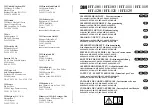
Functions
2.21 Fault Locator
SIPROTEC, 7SD5, Manual
C53000-G1176-C169-5, Release date 02.2011
390
Figure 2-181
Single-level arrangement with central phase
Parallel line measured value correction (single-ended fault locating)
In the case of earth faults on double circuit lines, the measured values obtained for calculation of the impedance
are influenced by the mutual coupling of the earth impedance of
both
parallel lines. This causes measuring
errors in the result of the impedance computation unless special measures are taken. The device is therefore
provided with a parallel line compensation function. This function takes the earth current of the parallel line into
consideration when solving the line equation, thereby compensating for the coupling influence as was the case
with the derivation of the distance by the distance protection (refer to Section 2.5.1 under „Parallel Line Mea-
sured Value Correction“). The earth current of the parallel line must, of course, be connected to the device and
the current input
I
4
must be configured accordingly during the setting of the
General Power System Data
(Power System Data 1)
(Section 2.1.2.1 under „Current Transformer Connection“).
The parallel line compensation only applies to faults on the protected feeder. For external faults, including those
on the parallel line, compensation is impossible.
Correction of measured values for load current on double-end fed lines (single-ended fault locator)
When faults occur on loaded lines fed from both ends (Figure 2-182), the fault voltage U
F1
is influenced not only
by the source voltage E
1
, but also by the source voltage E
2
, when both voltages are applied to the common
earth resistance R
F
. This causes measuring errors in the result of the impedance computation unless special
measures are taken, since the current component
I
F2
cannot be seen at the measuring point M. For long heavily
loaded lines, this can give a significant error in the X–component of the fault impedance (the determining factor
for the distance calculation).
For single-ended fault location calculation, a load compensation feature is provided in the 7SD5 which largely
corrects this measurement inaccuracy. Correction for the R–component of the fault impedance is not possible;
but the resultant inaccuracy is not critical, since only the X–component is critical for the distance to fault indi-
cation.
Load compensation is effective for single–phase faults. Positive and zero phase sequence components are
used in the compensation.
Load compensation can be switched on or off. Switching it off is useful, for example, during relay testing in order
to avoid influences caused by the test quantities.
















































